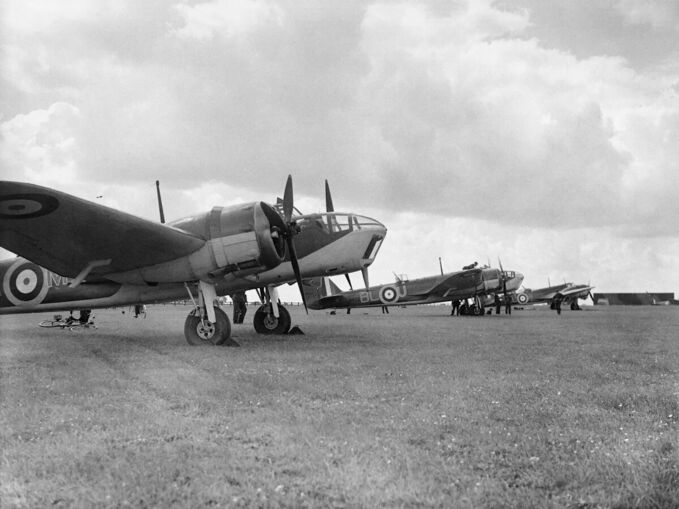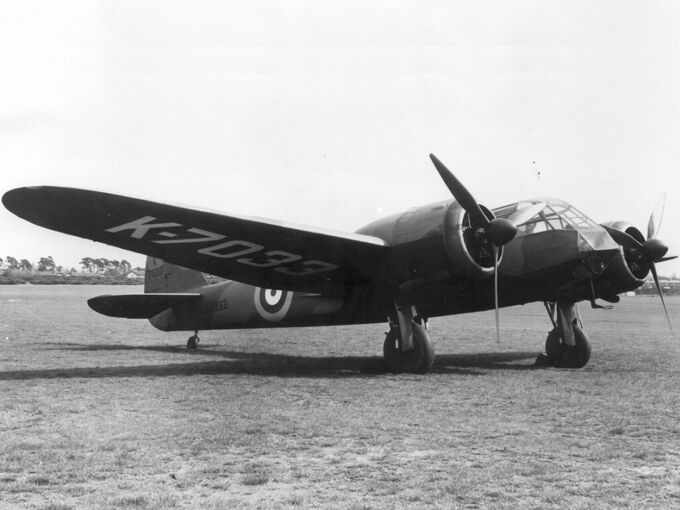The Bristol Blenheim is a very important piece of British aviation. It was the first all-metal monoplane aircraft of the RAF, the fastest combat aircraft in the world when introduced and the aircraft on which many future crews of more famous bomber aircraft learnt their trade.
Design
The Blenheim’s progenitor was the Bristol Type 142, a high-speed, twin-engined monoplane private aircraft, designed by The Bristol Aeroplane Company for Lord Rothermere, a politician and media baron.
Upon seeing the speed of the Type 142 in 1935, Lord Rothermere saw the potential to give the RAF a bleeding-edge new bomber aircraft. At the time the RAF was still using large biplane bombers such as the Boulton Paul Overstrand which had entered service that year and had a maximum speed of 148mph. The Type 142 was capable of speeds over 300mph, so it had considerable promise. He thus 'presented' the design to the nation, renaming it “Britain First”. Trials were promising so Bristol began work on a military variant. The resulting Type 142M (M for Military) had a new nose, new fuel tanks, higher-mounted wings and a host of other modifications such as gun turrets and other military equipment. The new bomber, although slower than the Type 142, was still faster than every other bomber in service, and could outrun most of the fighters in service at the time
Service History
Pre-War
The Blenheim entered service with a bang in March 1937 after 8 months of trials. 114 Squadron took delivery of the first bombers and quickly found they were far superior to the wood and canvas biplanes they had used until recently. There were several accidents as crews got used to the more powerful machine, especially the unforgiving hydraulic brakes; a few Blenheims were flipped over by pilots who used the brake with a little too much enthusiasm.
Despite this the Blenheim was very popular with crews grateful for the enclosed cockpit, excellent performance and relatively easy handling and it proved a massive draw to airshows such as the annual RAF Display at RAF Hendon.
In addition to the Blenheim bombers, a large number of Blenheim fighters were produced. These carried four .303in Browning machine guns in a large pack in place of the bomb bay. Ironically this modification reduced the top speed of the F (fighter) models by 20-30mph, meaning they struggled to catch more modern aircraft during the war. However the Blenheim’s size made it the perfect platform with which to test airborne radar systems. Blenheim Mark IFs were the first fighter aircraft to be fitted with and to use such systems in combat.
Wartime
Home Front
By the start of the Second World War in 1939, the Blenheim was no longer at the cutting edge of military aircraft design. In Germany, new all-metal monoplane fighters such as the vaunted Messerschmitt Bf 109 had already proved their dominance over the skies of Spain, and held a decisive edge in performance over the RAF’s “fast bomber”. By this point the Mark I had largely been replaced with the more powerful Mark IV — the version we have in-game — for squadrons stationed in the UK. It was a Blenheim Mark IV, piloted by Flight Officer Andrew McPherson, that made the first flight over Germany of the conflict, performing a reconnaissance mission over the German navy at Wilhelmshaven. The next day bombing raids were carried out, again on German warships at port. Unfortunately five of the ten Blenheims on the raid were lost, an early indicator of the type’s later troubles.
During the Battle for France in 1940, Blenheims, along with their Fairey Battle light bomber counterparts, flew large numbers of sorties to assist the British retreat on the ground. They now were up against more modern fighters with experienced pilots, meaning losses skyrocketed. On the 14 May, 14 Blenheims were lost, with 10 more on a single mission on the 17 May. The remaining overstretched and exhausted Squadrons were withdrawn from France on the 19 May, along with Fighter Command’s Spitfires and Hurricanes. The Blenheims still flew sortie after sortie to support the army. Over the skies of Dunkirk on the 3 June, the last day of the evacuation, 651 bombing missions were flown, largely by Blenheims.
Following the Fall of France, Blenheim squadrons were tasked with striking back across the Channel. The Blenheims were given almost all of the light bomber duties due to the Battles having been decimated over France in spring 1940. Further heavy losses didn’t stop crews from raiding Luftwaffe airfields by day and night, trying to relieve the pressure from Fighter Command during its Finest Hour. Some Blenheims were sent to Coastal Command as well, to try and protect vulnerable convoys from U-boats and surface attack — a campaign that cost the RAF 139 planes within a few months. The oft-forgotten fighter variants also saw some success, with a radar-equipped Mark IF making the first successful interception and kill of an enemy aircraft using airbourne radar on the night of the 22/23 July 1940.
Some of its final combat duties over Europe in 1941 were supporting “Bomber” Harris' famed Thousand Bomber Raids, Blenheims either making up the numbers due to heavier bombers being lost or flying intruder missions to disrupt night fighter operations. On the third of the massive raids on the 25/26 June, 51 Blenheims flew alongside the heavy bombers, while 31 attacked enemy airfields.
As the Blenheim was phased out of frontline combat duties on the Home Front, it found new roles in the Operational Training Units (OTUs) where it was used to train pilots, gunners, bomb-aimers and other bomber crew before they moved onto the newer, more capable, twin- and four-engined bombers such as the Lancaster. Some squadrons also converted straight to flying the latest, most powerful “fast bomber” — the de Havilland Mosquito, a move many crews were pleased with.
Overseas Operations
In the other theatres of the War, the Middle and Far East, the Blenheim continued to soldier on after leaving service on the Home Front, supporting operations in North Africa, Malta, Crete, Burma and the Pacific, often flying missions against overwhelming odds. Many modifications were carried out in-theatre to allow Blenheims to take on other duties, a more successful example being the fitting of a 20mm cannon in the nose of a few Mark Is in North Africa to allow them to act as impromptu ground attackers. Mark Is served in the Far East all the way until the Blenheim was removed from front line service, even as more powerful aircraft like the Beaufighter were introduced. The Mark Is and IVs was eventually replaced in part by the modified, over-weight Mark V, before all Blenheims were eventually removed from front line service in August 1943, the last mission being flown by Mark IVs of 60 Squadron.
Notable Achievements
Despite the Blenheim’s often poor service record, it was well-liked by its crews as it was quite a forgiving and easy aeroplane to fly, as well as being a reliable machine to work on. A few notable achievements are also attributed to Blenheims, including the death of ace pilot Lieutenant Colonel Tateo Katō of the Japanese Army Air Force, his Ki-43 being shot down by Blenheim gunner Flight Sergeant “Jock” McLuckie on 22 May 1942. In addition, three Victoria Crosses were awarded to Blenheim pilots, two posthumously, with the only survivor, Air Commodore Sir Hughie Edwards, receiving his for flying a Mark IV over Northern Europe.
Later Life
Despite leaving RAF service in 1943, the Blenheim would continue on in the service of many other countries, such as Finland, which had used the Blenheim extensively during the Winter War with Russia. The final Blenheim in active service was a Mark IV of the Yugoslav Air Force which flew the final mission in 1953, almost two decades after it entered service.
Conclusion
In conclusion, the Bristol Blenheim is often forgotten about, due to its poor record and obsolescence compared to more famous aircraft. However, it is a something of a hidden gem, as it was instrumental in the early part of the war. It then went on serving quietly to train the crews who flew to war in its more advanced successors. Many fell in love with the type, so much so that one can still be seen flying today, thanks to the efforts of one such pilot to salvage parts after the end of the war, a tribute to the bravery and sacrifice of those “Blenheim Boys”.







